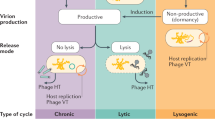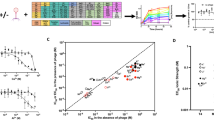Abstract
The persistence and interaction between newly isolated strains ofPseudomonas aeruginosa and resident bacteriophages indigenous to a freshwater environment was monitored over 45 days in lake water microcosms. The interaction between susceptible and resistant bacteria with pure phage (UT1) particles or a mixed phage population (M1) was investigated by following temporal changes in host density, phage-to-bacteria ratio (PBR), and the appearance of apparent prophage carriers within the host population. Decay rates of the phage (UT1) ranged from 0.054 hour−1 in natural water to 0.027 hour−1 in filtered lake water. About 45% of sensitive bacteria incubated with phase UT1 were pseudolysogenic within 12 hours of incubation in natural lake water. This process was delayed until 72 hours in the steile lake water control, suggesting that host-phage interaction is promoted in the presence of a viable natural microbial community. Phage UT1 appeared to stabilize the density of host bacteria in lake water at a level of 104 colony-forming units (cfu) ml−1. Bacterial coexistence with the mixed phage (M1) population resulted in an oscillating equilibrium with the PBR stabilizing at about 3. The presence of extraneous homoimmune phages appeared to be detrimental to the stability of the pseudolysogens, which were maintained at a lower population density than prophage-free cells in lake water containing the mixed phage (M1) population.
Similar content being viewed by others
References
Anderson ES (1957) The relations of bacteriophage to bacterial ecology. Seventh Symp. Soc. Gen. Microbiol. Royal Institution, London. Cited in Farrah SR (1987) Ecology of phage in freshwater environments. In: Goyal SM, Gerba CP, Bitton G (eds.). Phage ecology. Wiley-Interscience, New York, pp 125–136
Barksdale L, Arden SB (1974) Persisting bacteriophage infections, lysogeny, and phage conversion. Annu Rev Microbiol 25:265–299
Bartell PF, Orr TE (1969) Origin of polysaccharide depolymerase associated with bacteriophage infections. J Virol 3:290–296
Boyd JSK (1951) Cited in Kay D (1972) Methods for studying infectious properties and multiplication of bacteriophages. Methods Microbiol 7(A):191–262
Brown F(1986) The classification and nomenclature of viruses: Summary of results of meetings of the International Committee on Taxonomy of Viruses in Sendai. September, 1984. Intervirology 25:141–143
Campbell AM (1961) Conditions for the existence of bacteriophage. Evolution 15:153–165
Freeman V (1952) Further observations on the changes to virulence of bacteriophage-infected avirulent strains ofCorynebacterium diphtheria. J Bacteriol 63:407–414
Gould WD, Hagedon C, Berdinelli TR, Zabiotowicz RM (1985) New selective media for enumeration and recovery of fluorescent pseudomonads from various habitats. Appl Environ Microbiol 49:28–32
Grant MA, Holt JG (1977) Medium for the selective isolation of members of the genusPseudomonas from natural habitats. Appl Environ Microbiol 33:1222–1224
Grimont F, Grimont PAD, duPasquire P (1978) Morphological study of five phages of yellow pigmentedEnterobacteria. Curr Microbiol 1:37–40
Hendrix RW, Roberts JW, Stahl FW, Weisberg RA (eds) (1983) Lambda II. Cold Spring Harbor Laboratory, Cold Spring Harbor, New York
Hershberger CL, Rosteck Jr PR (1985) Method for conferring bacteriophage resistance to bacteria. US Patent 4,530,904
Holloway BW (1960) GroupingPseudomonas aeruginosa by lysogenicity and pyocinogenicity. J Pathol Bacteriol 80:448–450
Horne MT (1970) Coevolution ofEscherichia coli and bacteriophages in chemostat culture. Science 168:992–993
Kokjohn TA, Miller RV (1988) Characterization of thePseudomonas aeruginosa recA gene: The Les-phenotype. J Bacteriol 170:578–582
Lenski RE, Levin BR (1985) Constraints on the coevolution of bacteria and virulent phage: A model, some experiments, and prediction for natural communities. Am Nat 125:585–602
Levin BR, Steward FM, Choa L (1977) Resource limited growth, competition, and predation: A model and some experimental studies with bacteria and bacteriophage. Am Nat 111:3–24
Liang LN, Sinclair JL, Mallory LM, Alexander M (1982) Fate in model ecosystems of microbial species of potential use in genetic engineering. Appl Environ Microbiol 44:708–714
Limsowtin GKW, Terzaghi BE (1976) Phage resistant mutants: Their selection and use in cheese factories. NZ J Diary Sci Technol 11:251–256
Maniatis TE, Fritsch F, Sambrook J (1982) Molecular cloning: A laboratory manual. Cold Spring Harbor Laboratory, Cold Spring Harbor, New York
Marshall RJ, Berridge NJ (1976) Selection and some properties of phage-resistant starters for cheese making. J Dairy Res 43:449–458
Morrison WD, Miller RV, Sayler GS (1979) Frequency of F116-mediated transduction ofPseudomonas aeruginosa in a freshwater environment. Appl Environ Microbiol 36:724–730
Novack D (1968) A regulatory model for steady state conditions in populations of lysogenic bacteria. J Theor Biol 18:1–8
Patterson AC (1965) Bacteriology and lysogeny in the genusPseudomonas. J Gen Microbiol 39:295–303
Primrose SB, Day M (1977) Rapid concentration of bacteriophages from aquatic habitats. J Appl Bacteriol 42:417–427
Rissler JF (1984) Research needs for biotic environmental effects of genetically engineered microorganisms. Recomb DNA Tech Bullet 7:20–30
Sanders ME (1987) Bacteriophages of industrial importance. In: Goyal SM, Gerba CP, Bitton G (eds) Phage ecology. Wiley-Interscience, New York, pp 211–244
Saye DJ, Ogunseitan O, Sayler GS, Miller RV (1987) Potential for transduction of plasmids in a natural freshwater environment: Effect of plasmid donor concentration and the natural community on transduction inPseudomonas aeruginosa. Appl Environ Microbiol 53:987–995
Sayler GS, Lund LC, Shiaris MP, Sherrill TW, Perkins RE (1979) Comparative effects of Aroclor 1254 and phenanthrene on glucose uptake velocities by freshwater microbial populations. Appl Environ Microbiol 37:878–885
Sayler GS, Shields MS, Breen A, Tedford ET, Hooper S, Sirotkin KM, Davis JW (1985) Applications of DNA:DNA colony hybridization to the detection of catabolic genotypes of environmental samples. Appl Environ Microbiol 49:1295–1303
Shilo M (ed) (1979) Life under conditions of low nutrient concentrations: Strategies of life in extreme environments. Dahlem konferenzen life sciences research report B. Verlag, Chemie weinheim, FRG, pp 357–372
Silhavy TJ, Berman ML, Enquist LW (1984) Experiments with gene fusions. Cold Spring Harbor Laboratories, Cold Spring Harbor, New York
Stewart FM, Levin BR (1984) The populations biology of bacterial viruses: Why be temperate. Theor Pop Biol 26:93–117
Uetake H, Luria SE, Burrows JW (1958) Conversion of somatic antigens inSalmonella by phage infection leading to lysis or lysogeny. Virology 5:68–91
Wiggins BA, Alexander M (1985) Minimum bacterial density for bacteriophage replication: Implications for significance of bacteriophages in natural ecosystems. Appl Environ Microbiol 49:19–23
Williams ST, Mortimer AM, Manchester L (1987) Ecology of soil bacteriophages. In: Gyal SM, Gerba CP, Bitton G (eds) Phage ecology. Wiley-Interscience, New York, pp 157–179
Zachary A (1978) An ecology study of bacteriophage ofVibrio. Can J Microbiol 24:321–324
Author information
Authors and Affiliations
Rights and permissions
About this article
Cite this article
Ogunseitan, O.A., Sayler, G.S. & Miller, R.V. Dynamic interactions ofPseudomonas aeruginosa and bacteriophages in lake water. Microb Ecol 19, 171–185 (1990). https://doi.org/10.1007/BF02012098
Issue Date:
DOI: https://doi.org/10.1007/BF02012098




